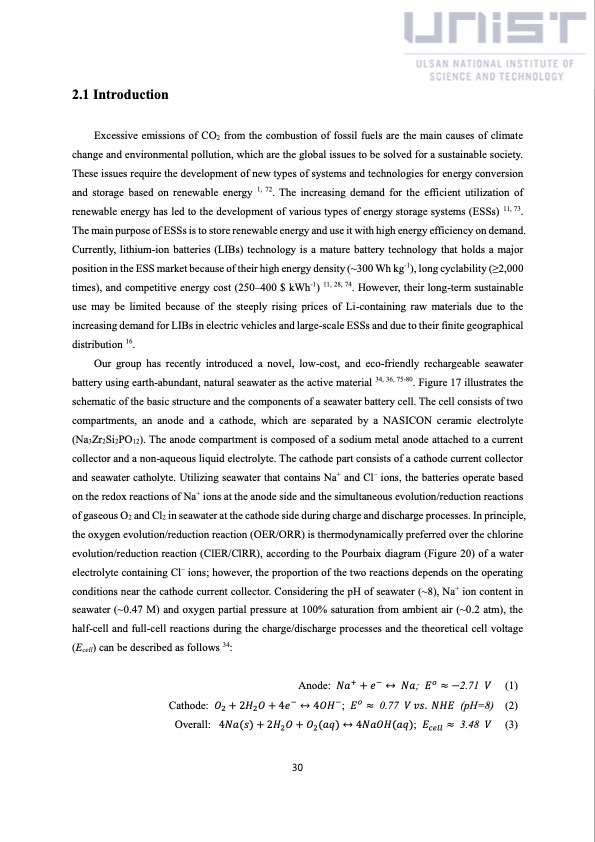
PDF Publication Title:
Text from PDF Page: 035
2.1 Introduction Excessive emissions of CO2 from the combustion of fossil fuels are the main causes of climate change and environmental pollution, which are the global issues to be solved for a sustainable society. These issues require the development of new types of systems and technologies for energy conversion and storage based on renewable energy 1, 72. The increasing demand for the efficient utilization of renewable energy has led to the development of various types of energy storage systems (ESSs) 11, 73. The main purpose of ESSs is to store renewable energy and use it with high energy efficiency on demand. Currently, lithium-ion batteries (LIBs) technology is a mature battery technology that holds a major position in the ESS market because of their high energy density (~300 Wh kg-1), long cyclability (≥2,000 times), and competitive energy cost (250–400 $ kWh-1) 11, 28, 74. However, their long-term sustainable use may be limited because of the steeply rising prices of Li-containing raw materials due to the increasing demand for LIBs in electric vehicles and large-scale ESSs and due to their finite geographical distribution 16. Our group has recently introduced a novel, low-cost, and eco-friendly rechargeable seawater battery using earth-abundant, natural seawater as the active material 34, 36, 75-80. Figure 17 illustrates the schematic of the basic structure and the components of a seawater battery cell. The cell consists of two compartments, an anode and a cathode, which are separated by a NASICON ceramic electrolyte (Na3Zr2Si2PO12). The anode compartment is composed of a sodium metal anode attached to a current collector and a non-aqueous liquid electrolyte. The cathode part consists of a cathode current collector and seawater catholyte. Utilizing seawater that contains Na+ and Cl– ions, the batteries operate based on the redox reactions of Na+ ions at the anode side and the simultaneous evolution/reduction reactions of gaseous O2 and Cl2 in seawater at the cathode side during charge and discharge processes. In principle, the oxygen evolution/reduction reaction (OER/ORR) is thermodynamically preferred over the chlorine evolution/reduction reaction (ClER/ClRR), according to the Pourbaix diagram (Figure 20) of a water electrolyte containing Cl– ions; however, the proportion of the two reactions depends on the operating conditions near the cathode current collector. Considering the pH of seawater (~8), Na+ ion content in seawater (~0.47 M) and oxygen partial pressure at 100% saturation from ambient air (~0.2 atm), the half-cell and full-cell reactions during the charge/discharge processes and the theoretical cell voltage (Ecell) can be described as follows 34: Anode: 𝑁𝑎+ +𝑒− ↔ 𝑁𝑎; 𝐸𝑜 ≈−2.71 𝑉 (1) Cathode: 𝑂2 + 2𝐻2𝑂 + 4𝑒− ↔ 4𝑂𝐻−; 𝐸𝑜 ≈ 0.77 𝑉 𝑣𝑠. 𝑁𝐻𝐸 (pH=8) (2) Overall: 4𝑁𝑎(𝑠) + 2𝐻2𝑂 + 𝑂2(𝑎𝑞) ↔ 4𝑁𝑎𝑂𝐻(𝑎𝑞); 𝐸𝑐𝑒𝑙𝑙 ≈ 3.48 𝑉 (3) 30PDF Image | China solar seawater battery

PDF Search Title:
China solar seawater batteryOriginal File Name Searched:
solar-seawater.pdfDIY PDF Search: Google It | Yahoo | Bing
Product and Development Focus for Salgenx
Redox Flow Battery Technology: With the advent of the new USA tax credits for producing and selling batteries ($35/kW) we are focussing on a simple flow battery using shipping containers as the modular electrolyte storage units with tax credits up to $140,000 per system. Our main focus is on the salt battery. This battery can be used for both thermal and electrical storage applications. We call it the Cogeneration Battery or Cogen Battery. One project is converting salt (brine) based water conditioners to simultaneously produce power. In addition, there are many opportunities to extract Lithium from brine (salt lakes, groundwater, and producer water).Salt water or brine are huge sources for lithium. Most of the worlds lithium is acquired from a brine source. It's even in seawater in a low concentration. Brine is also a byproduct of huge powerplants, which can now use that as an electrolyte and a huge flow battery (which allows storage at the source).We welcome any business and equipment inquiries, as well as licensing our flow battery manufacturing.| CONTACT TEL: 608-238-6001 Email: greg@salgenx.com | RSS | AMP |